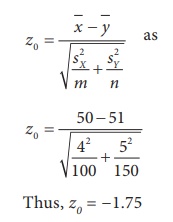Procedure Steps, Example Solved Problems | Statistics - Test of Hypotheses For Equality of Means of Two Populations (Population Variances are Unknown) | 12th Statistics : Chapter 1 : Tests of Significance - Basic Concepts and Large Sample Tests
Chapter: 12th Statistics : Chapter 1 : Tests of Significance - Basic Concepts and Large Sample Tests
Test of Hypotheses For Equality of Means of Two Populations (Population Variances are Unknown)
TEST OF HYPOTHESES FOR EQUALITY OF MEANS OF TWO POPULATIONS (POPULATION
VARIANCES ARE UNKNOWN)
Procedure:
Step-1 : Let µX and σX2 be respectively the mean
and the variance of Population -1. Also, let µY and
σY2 be respectively the mean
and the variance of Population -2 under study. Here σX2 and σY2 are assumed to be
unknown.
Frame the null hypothesis as H0: µX =
µY and choose the suitable alternative hypothesis from
(i) H1: µX ≠ µY
(ii) H1: µX> µY (iii) H1:
µX< µY
Step 2 : Let (X1, X2, …, Xm) be a
random sample of m observations drawn from Population-1
and (Y1, Y2, …, Yn) be a random
sample of n observations drawn from Population-2, where m and n
are large (m ≥30 and n ≥30). Here, these two samples are assumed
to be independent.
Step 3 : Specify the level of significance, α.
Step 4 : Consider the test statistic

i.e., the
above test statistic is obtained from Z considered in the test described in Section 1.11 by substituting SX2 and SY2 respectively
for σX2 and σY2
The approximate sampling distribution of the test
statistic  under H0 is
the N(0,1) distribution.
under H0 is
the N(0,1) distribution.
Step 5 : Calculate the value of Z for the given samples
(x1, x2, ...,xm) and (y1,
y2, …, yn) as

Here ![]() and
and ![]() are respectively the values of
are respectively the values of ![]() and
and ![]() for the given samples.
for the given samples.
Also,
sx2 and sy2 are respectively the
values of SX2 and SY2 for the given
samples.
Step 6 : Find the critical value, ze,
corresponding to α and H1 from the following
table

Step 7 : Make decision on H0 choosing the
suitable rejection rule from the following table corresponding to H1.

Example 1.11
A Model Examination was conducted to XII Standard students in the
subject of Statistics. A District Educational Officer wanted to analyze the
Gender-wise performance of the students using the marks secured by randomly
selected boys and girls. Sample measures were calculated and the details are presented
below:

Test, at 5% level of significance, whether performance of the
students differ significantly with respect to their gender.
Solution:
Step 1 : Let μX and μY denote
respectively the average marks secured by boys and girls in the Model
Examination conducted to the XII Standard students in the subject of
Statistics. Then, the null and the alternative hypotheses are
Null hypothesis: H0: µ X = µY
i.e., there is no significant difference in the performance of the
students with respect to their gender.
Alternative hypothesis: H1 : µ X ≠ µY
i.e., performance of the students differ significantly with the
respect to the gender. It is
a two-sided alternative hypothesis.
Step 2 : Data
The given sample information are

Since m ≥ 30 and n ≥ 30, both the samples are large.
Step 3 : Level of significance
α= 5%
Step 4 : Test statistic
The test statistic under H0 is

The sampling distribution of Z under H0
is the N(0,1) distribution.
Step 5 : Calculation of the Test Statistic
The value of Z is calculated for the given sample
informations from

Step 6 : Critical value
Since H1 is a two-sided alternative, the critical value at 5% level of significance is ze = z0.025 = 1.96.
Step 7 : Decision
Since H1 is a two-sided alternative, elements of the critical region are determined by the rejection rule |z0| ≥ z0 . Thus it is a two-tailed test. But, |z0|= 1.75 is less than the critical value ze = 1.96. Hence, it may inferred as the given sample information does not provide sufficient evidence to reject H0. Therefore, it may be decided that there is no sufficient evidence in the given sample to conclude that performance of boys and girls in the Model Examination conducted in the subject of Statistics differ significantly.
Related Topics